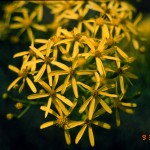Riddell Groundsel, Broom Groundsel
Senecio riddellii
Asteraceae (Sunflower Family)
Description
Riddell groundsel is a herbaceous perennial of the sunflower family. The leaves are hairless and bright green. Yellow flowers emerge in the fall (September to November). The plant dies back to the ground after frost.
Habitat
Riddell groundsel is a common range plant in Colorado and Utah, and south to Texas and Mexico. It is a common plant of grassland areas of western Texas. It increases in abundance with disturbance and overgrazing.
Toxic Agent
Riddell groundsel owes its toxicity to pyrrolizidine alkaloids. When the plant is stressed from lack of water, its alkaloid content increases. Cattle and horses are about equally sensitive to this plant. Sheep and goats are more resistant, generally requiring up to 10 times the amount for the same effect as in cattle and horses. For acute poisoning, cattle and horses generally must eat 1 to 5 percent of their weight in riddell grounsel over a few days. This type of poisoning is rare under range conditions. Most cattle and horse losses are from chronic poisoning, which can be caused by their consuming as little as 0.25 percent of their body weight in the plant.
Signs of Livestock Ingestion
Often up to 6 months elapse between consumption of this plant and the appearance of chronic signs. During this period, the animal may even gain weight and appear thrifty. First signs of poisoning include: Standing apart from other animals; Depression or sluggishness; Lack of appetite; Weight loss.
The advanced stage of the disease is characterized by: Continuous walking, sometimes without avoiding objects; Sudden nervous appearance upon disturbance; Frequent voiding of small amounts of urine; Bile-stained (yellow) feces; Rectal prolapse (cattle); Skin swollen with excessive fluid and possibly emitting a sweetish, unpleasant odor; Conversely, death occurring quickly or quietly after a period of depression.
In the advanced stage, animals may remain relatively quiet or become agitated and dangerously aggressive.
Examination after death may reveal a hardened liver (possibly mottled coloration). The gall bladder may be distended, frequently to an enormous size.
Management Strategies
There is no treatment for pyrrolizidine alkaloid toxicity because the liver damage is severe, progressive and permanent. Range management practices that improve range condition reduce losses to riddell groundsel. Proper mineral supplementation, especially with phosphorus, also helps.
Images
Plant Characteristics
Flower Color: Yellow
Seed Type: Non-Encapsulated
Duration: Perennial
Stem Texture: Hairless/Smooth
Growth Habit: Forbs/Broadleaf
Leaf Shape
 : Simple with Pinnate or Parallel Venation
: Simple with Pinnate or Parallel Venation
Season: Warm
Distribution
 : 02 - Gulf Prairies and Marshes, 06 - South Texas Plains, 07 - Edwards Plateau, 08 - Rolling Plains, 09 - High Plains, 10 - Trans-Pecos
: 02 - Gulf Prairies and Marshes, 06 - South Texas Plains, 07 - Edwards Plateau, 08 - Rolling Plains, 09 - High Plains, 10 - Trans-Pecos
Distributions
Distribution refers to the ecological region in Texas that a plant has been found. You can also view a clickable map.
Book: Toxic Plants of Texas (B-6105)
Collection: Toxics, Wild Flowers
Livestock Affected: Cattle, Goats, Horses, Sheep
Livestock Signs: Abnormal Urination, Anorexia, Continuous Walking, Depression/ Weakness, Excitability, Loss Of Weight, Pushing On Objects, Running Into Objects




